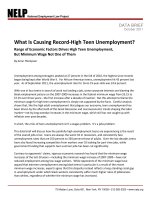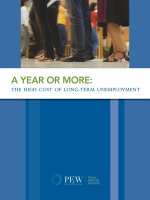What Is Causing Record-High Teen Unemployment? pot
Bạn đang xem bản rút gọn của tài liệu. Xem và tải ngay bản đầy đủ của tài liệu tại đây (820.07 KB, 7 trang )
75 Maiden Lane, Suite 601, New York, NY 10038 ▪ 212-285-3025 ▪ www.nelp.org
National Employment Law Project
DATA BRIEF
October 2011
What Is Causing Record-High Teen Unemployment?
Range of Economic Factors Drives High Teen Unemployment,
But Minimum Wage Not One of Them
By Anne Thompson
Unemployment among teenagers peaked at 27 percent in the fall of 2010, the highest since records
began being kept after World War II. For African-American teens, unemployment hit 43 percent last
year. As of September 2011, the unemployment rate for 16-to-19-year-olds was 24.6 percent.
With one in four teens in search of work not landing a job, some corporate interests are blaming the
bleak employment picture on the 2007-2009 increases in the federal minimum wage from $5.15 to
$7.25 over three years—the first increase after a decade of inaction. But this attempt to blame the
minimum wage for high teen unemployment is simply not supported by the facts. Careful analysis
shows that, like the high adult unemployment that plagues our economy, teen unemployment has
been driven by the aftermath of the Great Recession and macroeconomic trends shaping the labor
market—not by long-overdue increases in the minimum wage, which still has not caught up with
inflation over past decades.
In short, the crisis of teen unemployment isn’t a wages problem. It’s a jobs problem.
This data brief will discuss how the painfully high unemployment teens are experiencing is the result
of the overall jobs crisis: teens are always the worst hit in recessions, and consistently face
unemployment rates that are 250 percent to 350 percent those of adults. Over the last decade, teens
have also faced increasing competition from workers over 55 looking for part-time jobs, while
government funding that supports teen summer jobs has been cut significantly.
Contrary to opponents’ claims, rigorous economic research has found that the minimum wage
increases of the last 20 years—including the minimum wage increase of 2007-2009—have not
reduced employment among low-wage workers. While opponents of the minimum wage have
argued that extreme unemployment among black teens in particular is a result of the recent
minimum wage increases, experts agree that this disparity instead reflects a long-standing racial gap
in unemployment under which black workers consistently suffer much higher rates of joblessness
than whites, regardless of whether the minimum wage has increased.
2
Teens experience greater declines in employment during downturns.
During economic downturns, the teen employment rate falls further than the overall
employment rate because teens are the youngest, least experienced members of the
workforce, and therefore are disproportionately affected by job loss. Figure A, which
compares monthly employment rates for teens (16-to-19-year-olds) with the whole workforce
(those 16 and above), shows how the teen rate typically plummets far more than the adult
rate during recessions.
Note that the monthly employment rate referenced in figure A—the proportion of the
workforce with a job that month—is distinct from the unemployment rate. The latter reflects
the portion of the population that has been actively looking for work over the past four weeks
without success. Because the unemployment rate does not capture the sizeable population of
discouraged workers who have stopped looking for a job altogether in the face of a dismal
labor market, economists also use the employment rate to get a more complete picture of
joblessness.
Source: Bureau of Labor Statistics
Teens always experience greater unemployment than adults, and their
unemployment rate fluctuates in proportion to the overall unemployment rate.
With less experience and fewer skills than adults, teens are more likely to be unemployed.
They also exit and enter jobs more frequently than adults, and so are more likely to be
unemployed at any given point in time.
3
Since the end of World War II, the teen unemployment rate has ranged from two-and-a-half
to three-and-a-half times the overall employment rate. With overall unemployment at a
painful 9.1 percent, May’s teen unemployment rate of 24.2 falls within this historic range.
Source: Bureau of Labor Statistics
Over the past decade, teens have been facing greater competition for jobs from adult
workers, especially older workers.
The Baby Boomers began turning 55 in 2001. As they have aged over the past decade, large
numbers of older workers are looking for part-time work to help them cover their costs as
they begin to retire. They have created increased competition for jobs in the occupations
where teens are predominantly employed. These older workers, whom we now see at places
like Home Depot and Wal-Mart, are displacing many teens from the labor market.
A majority of teens work in food preparation and serving occupations, with sales and related
occupations ranking second. From 2000 to 2009, employment in food preparation and
serving increased nationally by 1.1 million. Every adult age group recorded employment gains
in these occupations, with workers over 55 growing the most by 128,000. By contrast, teen
employment in these jobs declined by 242,000.
1
The same is true in sales and related occupations: teens are being replaced by older workers
vying for employment. While overall employment levels have changed little in the field from
1
Morisi, Teresa. “The early 2000s: a period of declining teen summer employment rates” (May 2010). Monthly Labor
Review. Available at
4
2000 to 2009, teen employment in sales occupations fell by more than half a million. By
contrast, workers over 55 increased their employment by 822,000.
2
Not only has the proportion of the population over 55 grown since 2000, but a greater
proportion of seniors today than in the past simply need to keep working. Many seniors who
cannot afford to retire because of changes in Social Security, reductions in pensions and
retirement savings, and the need to make ends meet in this tough economy are taking part-
time “bridge” jobs that put them in competition with teen workers.
As Table 1 illustrates, employment rates fell for all workers under 55 over the past decade as
the labor market has suffered from two recessions. However, teens faced the most severe
reductions, while workers over 55 registered striking increases in employment.
Source: Bureau of Labor Statistics
The employment rate for workers aged 55 to 64 increased by 5 percent over the past decade,
while it rose 25 percent for 65-to-69-year-olds and a striking 33 percent for 70-to-74-year-
olds. At the same time, it fell 44 percent for teens.
Northeastern University economist Andrew Sum describes the dramatic age shift in
employment this way: “In June 2000, teens in the U.S. were more than twice as likely to have
a job as those adults 65-69 years old (51 percent versus 23 percent). By June 2010, these older
adults were modestly more likely to be working than teens (28.8 percent versus 28.6 percent),
an age reversal in employment outcomes never before seen in American history.”
3
2
Ibid.
3
Sum, Andrew and Khatiwada, Ishwar, “ Vanishing work among U.S. teens, 2000-10 : what a difference a decade
makes! Four million missing workers in June 2010” (2010). Center for Labor Market Studies Publications. Paper 29.
Available at
Table 1. Employment Rates by Age Groups in the U.S,
June 2000 to June 2010 (Not Seasonally Adjusted)
5
The number of federally funded summer jobs has fallen over the past decade.
In 2000, the Workforce Investment Act (WIA) replaced the Summer Youth Employment and
Training Program, which had financed jobs for 400,000 to 1.2 million teens each summer since
the 1960s. With the end of this program, federal funding dedicated solely to summer jobs
programs was eliminated. Moreover, the remaining federal funding for youth job programs
under WIA suffered further cuts over the next decade as funding declined 8 percent between
1999 and 2009.
4
Figure C shows the substantial drop off in summer employment offered by
local municipalities after federal funding shrank in 2000:
Source: Bureau of Labor Statistics
The 2009 American Reinvestment and Recovery Act (ARRA) dedicated $1.2 billion for summer
youth employment, helping 14-to-24-year-olds find jobs and putting approximately 320,000
16-to-19-year-olds to work. But since the ARRA, Congress has failed to extend funding for
teen summer jobs, substantially reducing summer hiring by municipalities across the country.
For example, Chicago is offering 22 percent fewer youth summer jobs this year than last: just
14,000 in 2011, down from 18,000 in 2010.
5
4
Morisi.
5
Knowles, Francine. “Jobs for only 25% of teens: study” (2 May 2010). The Chicago Sun-Times. Available at
6
The minimum wage increases of 2007-2009 have not caused job loss among teens.
Finally and most definitively, a recent study
6
by economists at the University of California and
the University of Massachusetts examined every state and federal minimum wage increase
over the past two decades and found that they did not lead to declines in teen employment.
Their analysis included an in-depth examination of minimum wage increases during times of
high unemployment—including the Great Recession of 2007 to 2009—and found that even
during these difficult economic periods when unemployment for both adults and teens
spiked, increases in the minimum wage did not exacerbate job losses or slow rehiring.
Equally important, the new study demonstrates how a body of previous research—one
frequently relied on by business lobbyists who oppose minimum wage increases—
inaccurately attributes declines in employment to increases in the minimum wage. It shows
how those studies ignore major differences in job markets such as varying regional growth
rates for low-wage jobs. When analyses control for these important factors, the claimed job
losses disappear.
Black teen unemployment has always been dramatically higher than overall teen
unemployment.
African-American teen unemployment hit 43 percent in 2010, a level not seen since the
recession of the early 1980s. Unfortunately, this shocking rate of unemployment is consistent
with our nation’s long-term racial gap in unemployment. Since the U.S. Department of Labor
began keeping statistics in 1972, the black teen unemployment rate has ranged from 1.6 to
2.4 times the overall teen unemployment rate. In 2010, the black teen unemployment rate of
43 percent was 1.7 times the overall teen unemployment rate of 25.9 percent—well within
that range. The problem of extreme unemployment among black youth is a persistent one
that our nation has failed to adequately address for decades, but the evidence does not
suggest that the minimum wage is driving or exacerbating it in any way.
The racial unemployment gap among teens reflects a dramatic unemployment gap between
blacks and whites that has existed for more than 60 years. Black unemployment has been
roughly double the overall unemployment rate since World War II.
This racial unemployment gap is always worse during times of high unemployment. According
to Duke University economist William Darity, blacks are “the last to be hired in a good
economy, and when there’s a downturn, they’re the first to be released.”
7
6
Allegretto, Sylvia A., Arindrajit Dube and Michael Reich. “Do minimum wages really reduce teen employment?
Accounting for heterogeneity and selectivity in state panel data” (April 2011). Industrial Relations, Vol. 50, No. 2. Available
at
7
Kroll, Andy. “What we don’t talk about when we talk about jobs” (5 July 2011). The Huffington Post. Available at
7
An Economic Policy Institute analysis of Bureau of Labor Statistics data found that blacks with
the same education as whites have consistently lower employment levels. This employment
gap persists across all education levels, whether examining high-school dropouts or
individuals with college degrees.
8
In fact, a recent experiment found that employers called back job applicants with white-
sounding names at far higher rates than applicants with identical resumes but black-sounding
names.
9
Conclusion
Attempts to blame the current crisis in teen unemployment on the minimum wage are based on
ideological opposition to the minimum wage, not on facts. Instead, the data show that teen
unemployment remains frustratingly high because unemployed workers still outnumber job openings
by more than four to one. Similarly, while unemployment among African-American teens is even
more dire, black workers continue to suffer disproportionately when labor markets are weak due to a
range of factors unrelated to the minimum wage.
The crisis of teen unemployment isn’t a wages problem. It’s a jobs problem. Raising the minimum
wage will benefit teen and African American workers, not hurt them.
About the National Employment Law Project
The National Employment Law Project is a non-partisan, not-for-profit organization that conducts
research and advocates on issues affecting low-wage and unemployed workers. For more than 40
years, NELP has sought to ensure that work is an anchor of economic security and a ladder of
economic opportunity for working families across America. In partnership with grassroots and
national allies, NELP promotes policies to create good jobs, enforce hard-won workplace rights, and
help unemployed workers regain their economic footing. For more about NELP, please visit
www.nelp.org.
8
Ibid.
9
Bertrand, Marianne, and Mullainathan, Sendhil, “Are Emily and Greg More Employable than Lakisha and Jamal? A field
experiment on labor market discrimination” (June 2004). Available at
and summary









